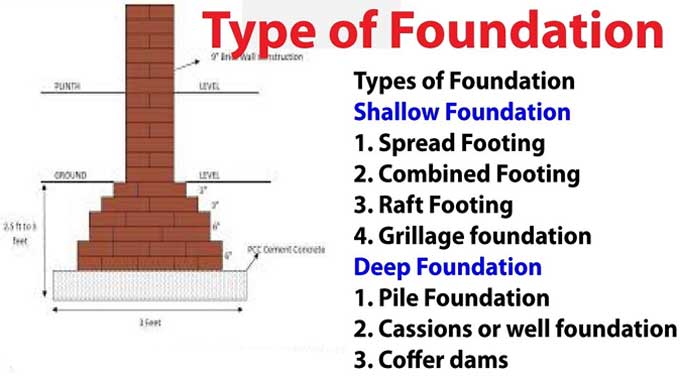
Types of Foundation and their Uses in Building Construction

Several structures such as bridges, dams, roads, and buildings are built by civil engineers to serve various requirements. Structures apply load on the soil on which they rest. If any structures are placed directly on the ground, the ground's soil will get overstressed and will not be able to support the structure safely. To safely distribute the load of the soil structure, some part of the structure is placed under the ground.
That part of the structure is known as the sub-structure, which is usually called a foundation. Foundation is defined as the part of a structure that transfers the load of the structure on it and the weight over a large area of soil in a way that the ultimate bearing capacity of the soil and the weight of the whole structure are within limits.
In layman's terms, the part of a structure on which a building stands is known as a foundation, and the solid ground on which the foundation rests is called a foundation bed.
Objectives of a Foundation
The main objectives of a foundation are:
1. Avoid dissimilar settlement
2. Increase the firmness of the structure
3. Distributing weight of the structure over a large area of the soil
4. To prevent any lateral movement of the structure
What is Foundation Engineering?
Foundation Engineering is a field of study developed for students to study the structure's design, which supports other structures, most usually bridges, buildings, or infrastructures for transportation. It comes under the same circle as Structural, Civil, and Geotechnical Engineering. Foundation Engineering has a particular focus on soil-structure interaction.
Types of Foundation
Usually, all foundations are divided into two main categories - Deep and shallow foundations. These terms refer to the depth of the soil at which it is placed.
If the width of the foundation is greater than its breadth, it is generally known as the "Shallow Foundation." If the width is smaller than the depth of the foundation, then it is usually known as "Deep foundation."
Shallow Foundations
Shallow foundations are economical in nature, and the depth of the foundation is low. It is the most popular type of foundation and is used as a foundation for lightweight structures.
There are several kinds of shallow foundations like:
Isolated Spread Footing: It is the most recognizable and most uncomplicated type of shallow foundation. It is also the most budget-friendly option among others
Strip footing or Wall Footing: Strip footing is also known as continuous footing. Strip footing is used to dispense loads of non-structural or structural load-bearing walls to the ground surface in a kind of way that the load-bearing limit of the soil will not be surpassed.
Combined footing: Combined footing is a spread footing that supports two columns or greater is known as combined footing.
Strap footing or Cantilever: A footing is called a strap footing when the isolated spread footings of two columns are connected by a strap beam.
Mat or Raft foundation: Mat or Raft footings is a kind of combined footing that covers an entire area underneath a structure and supports all the columns and walls.
Deep Foundations
Deep foundations are those foundations that transfer the load deeper into the soil. Deep foundations are used when the soil at shallow depth cannot support a structure.
To learn more, watch the following video tutorial.
Video Source: Civil Engineering Global
There are several kinds of deep foundations like:
Pile Foundation: Pile, is the recurrent type of deep foundation. They are used for cost reduction and according to soil quality considerations.
Pier Foundation: Piers is an below the surface structure that transmits a considerable load, which could not have been carried by any kind of shallow foundations.
Cassion or Well foundation: Cassion or Well foundation is sunk deep inside the ground to support heavy loads. It looks like a large hollow box and is very huge in shape. These foundations are generally used in the construction of bridges.


